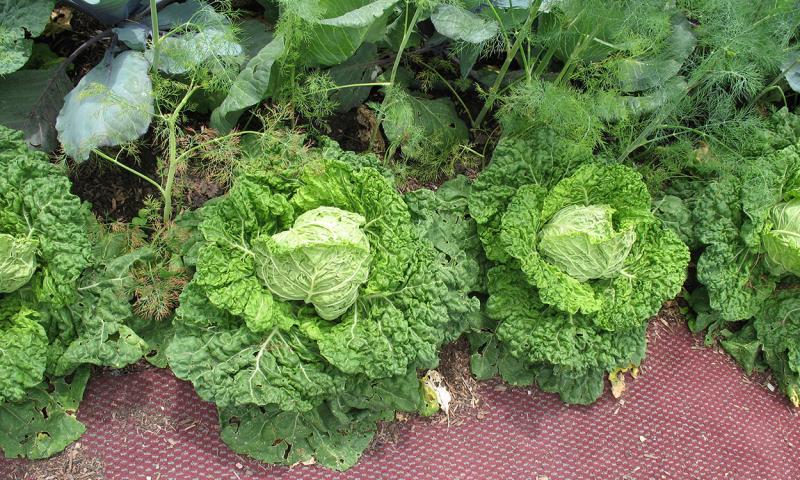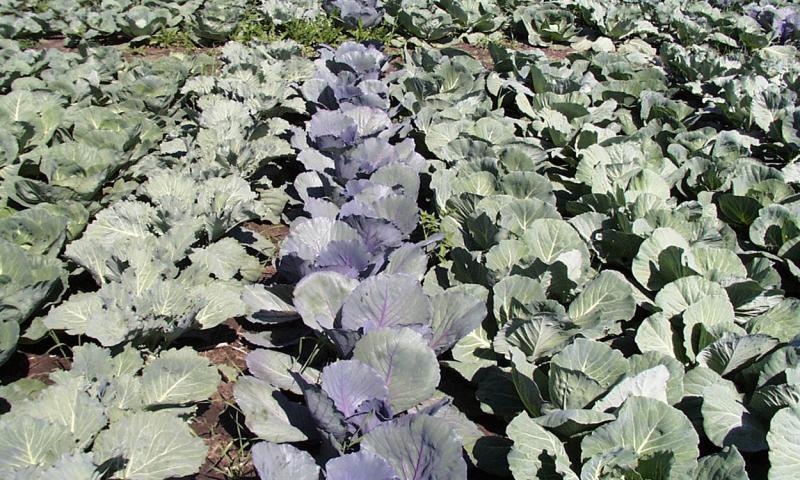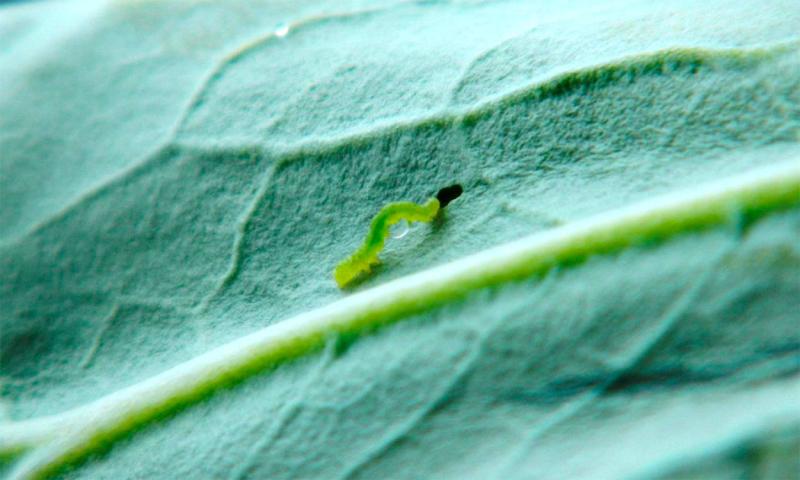Written by Rhoda Burrows, former Professor & SDSU Extension Horticulture Specialist.
Description

General Description: Cabbages are cool-season crops, very closely related to broccoli, cauliflower, kale, kohlrabi and brussels sprouts. They have been cultivated in some form since at least 2000 B.C., having been an important source of Vitamins C and A during the winter. In the 1700s it was found that sauerkraut (fermented cabbage) could prevent the deadly scurvy that killed many sailors on long sea voyages. Cabbage also contains cancer-fighting chemicals.
Types: Depending on the variety, cabbages may be round or somewhat elongated and pointed, and they may vary from bright green to a more sage green or even purple! Savoy cabbages have deeply indented leaves and a somewhat looser head. Chinese cabbages are a different species; they are grown in much the same manner as other cabbages, but they are more sensitive to uneven temperatures, so they are a much less dependable crop.

In addition to those grown for food, there are ornamental cabbage varieties with fringed or ruffled leaves to bring late-season color to your flower beds. While technically edible, the ornamental varieties are usually quite bitter tasting.
Cabbages grow best in cooler the temperatures of spring or fall. In Alaska, they can grow very large (the world record was set there in 2012 with a 138-pound cabbage), in part because of the cooler temperatures and very long day lengths. There are both short-season varieties (ready as soon as 45 days after transplanting) and long-season varieties (100 days or more). Short-season varieties can be planted early so that they will mature before the hottest periods of the summer. When selecting long-season varieties for South Dakota, look for “heat-resistant” in the variety description.
Planting

Timeline: Cabbage seedlings are sensitive to frost (it may cause the plant to form flowers instead of heads), but they also need to be started early enough to avoid maturing during the hottest part of the summer. Starting plants indoors in the spring allows them to put on enough growth to mature before mid-summer. Heat-tolerant long season varieties (100+ days) can be either started indoors or direct-seeded in late-May or early June.
For a fall harvest, cabbage can be either transplanted or direct-seeded into the garden in early July (or through July for warmer areas of the state, or with short-season varieties). Mature plants can tolerate heavy frosts, down to about 24 degrees Fahrenheit. Chinese cabbage generally does best when planted for fall harvest, as it is very sensitive to spring frosts, or a week or more of night temperatures under 50 degrees Fahrenheit, as well as hot temperatures as it matures. Planting in the summer allows it to mature under the usually cooler temperatures of the fall.

Site Selection and Preparation: Choose a spot where no cole crops (cabbage, kale, broccoli, kohlrabi, Brussels sprouts or cauliflower) have been grown for several years to avoid diseases that can persist in the soil. Cabbage prefers a rich soil, so if you have not done so in the past year, work an inch or two of compost or other well-rotted organic matter into the top few inches of soil. Because of the possibilities of transferring human pathogens, never use fresh manure!
Sowing and Transplanting: Start transplants at room temperatures (do not use a heating mat), as higher temperatures will cause leggy plants, especially under lower-light conditions. Sow seed ¼ to ½ inch deep. When sowing directly into the garden, seed can be sown in clumps of three, with clumps spaced 1½ feet apart, or singly every four to six inches. In either case, the plants should be thinned once they have emerged, to allow 1½ to two feet between plants. Large headed, full-season varieties should be spaced further apart than smaller, shorter-season varieties. Closer spacing will result in smaller heads. If the plants are too crowded, they may not form heads at all.
Be sure to prepare your plants for life in the garden by hardening them off (gradually exposing them to outdoor conditions). Place them outdoors in the sunlight in a wind-protected area for just a few hours per day to start with; then gradually (over about a week) extend each day’s exposure by an hour or two. This will allow the plant to thicken its protective cuticle on its leaves to withstand both full sun and wind.
Be sure to keep the ground moist following seeding or transplanting. Mulch can help retain moisture and cool the roots, as well as keep down weeds.
Plant Care
Watering
- Cabbage needs to be well-irrigated for best quality, as drought may cause the flavor to become bitter, or even prevent the plant from forming heads.
- Make sure the soil is thoroughly wetted (to at least six inches deep) after each watering.
- Once plants have several true leaves, let the top half-inch or so dry before watering again so the soil does not stay saturated.
Fertilizer
- Nitrogen: When the plants have four or five true leaves, apply nitrogen sources, such as 46-0-0 (1/2 c.) or 27-3-3 (1 c.), per 100 feet of row, spreading it around the plant and lightly scratching it into the soil. If you have previously applied manure, the plants may not need additional fertilizer.
- Phosphorus and Potassium: apply according to soil test recommendations, as these nutrients are often sufficient in our soils, especially if manure has been applied previously.
Weeding and Mulching
- Frequent shallow cultivation or mulching is recommended to keep weeds under control.
- Cabbage is sensitive to competition from weeds, which can reduce head size through shading or through d
Pests and Diseases

Major Pests
- Moths: White cabbage moths and grey cabbage looper moths (Figure 5) lay eggs that hatch into green caterpillars that can chew holes in the leaves and may hide in a harvested cabbage head. Sprays of Bacillus thuringiensis (Bt) formulations can be effective if care is taken to spray the entire plant, including the undersides of the leaves and repeating after rain or overhead watering. Be certain cabbage worms are listed as targets on the pesticide label, as there are different formulations of Bt for different types of insect pests.
- Flea Beetles: Flea beetles chew small, round holes in leaves. This can heavily damage the crop, especially early in the growing season when plants are small. Mustard greens, such as arugula or radishes, planted near the cabbage can sometimes act as a trap crop, luring the beetles away from the cabbage.
- Row Covers: Lightweight row covers can exclude insects, such as moths and flea beetles, if placed before the pests are observed. If placed too late, the pests may hatch from eggs laid on the plants and have a wonderful, protected environment to feast on your plants!
Minor Problems
- Heavy rain can cause mature heads to split. If heavy rains are predicted, a few roots can be severed by twisting the head a quarter turn. This will help prevent the cabbage from taking up water too quickly.
- Heat may cause heads to be somewhat looser and less sweet.
Harvest and Storage
Timing: Cabbage heads can be harvested once they reach the desired size, and the heads feel firm to pressure (depending somewhat on variety). Keep in mind they may sweeten somewhat under cooler temperatures, so sometimes delaying harvest at bit in the fall leads to a better product.
Average Yield: Ten feet of row should yield 10 to 18 pounds.
Storage: Cabbage can last for months in a root cellar (ideally 32 to 40 degrees Fahrenheit) with high humidity. If stored in a refrigerator, place a damp towel within a crisper drawer or bag to keep the head from wilting.
Preparation
Cooking: For recipes and tips for preparing cabbage, view our Pick it! Try it! Like it! resource for cabbage.
Nutrition Facts: One cup of raw cabbage can provide over half of the daily recommended amount of Vitamin C and 85% of the daily recommended amount of Vitamin K for adults. Cabbage also contains an array of antioxidants that may help decrease inflammation, while also being high in fiber, which can increase healthy bacteria in the gut. Other compounds in cabbage appear to have cancer-fighting abilities.


